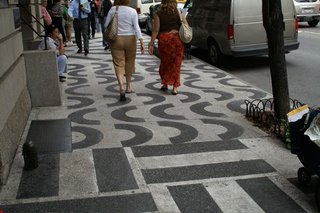
Few people know that Alexander Calder designed a sidewalk in front of 1014-1018 Madison Ave. between 78 and 79th streets. Calder's gallery was in the building and three galleries in the building split the installation cost of the sidewalk. The sidewalk is a few blocks up from the Whitney Museum where you can see Calder's Circus. The Whitney has a great display of the Circus and they run the Calder's Circus video. I used to teach a wire sculpture project and would show my students the video before they started their wire sculptures. The more I saw the video the more I realized that Calder was an early performance artist. Calder would perform the Circus in Paris and New York in the late 1920s and 1930s. The Circus is usually mentioned as Calder's link to kinetic art but the performance aspect is overlooked. If you get a chance to see the video do.
The reason I mention Calder is that I thought of him while watching Junebum Park's video entitled Parking at the Projected Realities, Video Art from East Asia exhibition at Asia Society. In the video a hand, the artist's I presume, appears to be moving cars in and out of a parking space. The video is a composite of the hand and actual cars going in and out of parking spaces. In a sense, Junebum Park, was manipulating the cars the way Calder manipulated the circus figures. I was very impressed with Park's work. Park's pieces are short and imaginative. Click here to read a review of his work and see stills from his video.
BTW the exhibition was dedicated to Nam June Paik and included the work of several other video artists. It would be nice if video artists and curators got together and offered a DVD of some of the work in video exhibitions.
2 comments:
I've had the wonderful privilage to see several of Calder's mobiles collected in both Philadelphia and a few years ago in the Storm King sculpture park, in NY state. Also worth mentioning is that Calder is a third generation sculptor. His father, Alexander Stirling Calder, was responsible for several public sculpture's including the fountains in front of the PMA (Phila. Museum of Art); and his grandfather, Alexander Milne Calder- concieved and oversaw the grand design programme covering Philadelphia's City Hall.
Both Alexander Calder and Piet Mondrian began with representational work, working away recognizable forms in their work to reveal the beauty of Nature's inimitable design. What we are familiar of now is worth seeing in context, with the entire body of both artists' work.
One could say that while Mondrian focused on the proportions he first observed in Trees, representing them as lines and rectangles; Calder honed in on the curvalinear forms of organic motion.
Like Marcel Duchamp- whose two brothers were among the most prominent sculptors & etchers in Europe; Calder came of age in the shadow of greatness. The distinctive directions taken by the each artist- Calder's almost child-like mobiles and Duchamp's defiantly unconventional ready-mades- are representative of a moment in history when artists themselves were allotted unprecedented freedom of personal expression. As with many artists of the time, but rarely so in so bold a manner- Marcel Duchamp, Piet Mondrian, and Alexander Calder each recognized their individual roles in redefining Art itself, and continued to do so with each consecutive work through their career.
Post a Comment